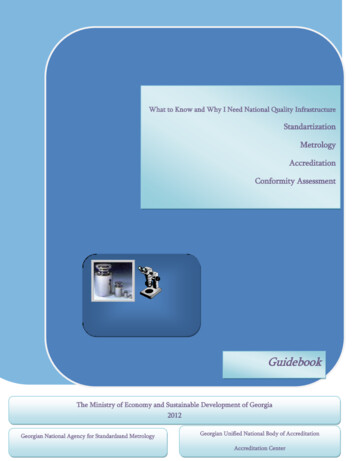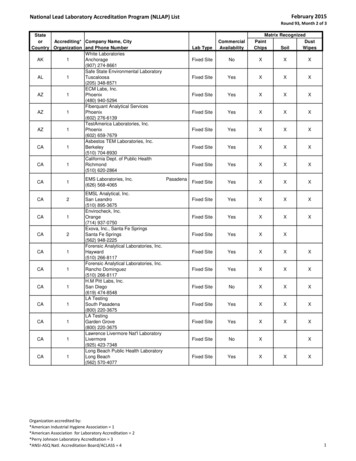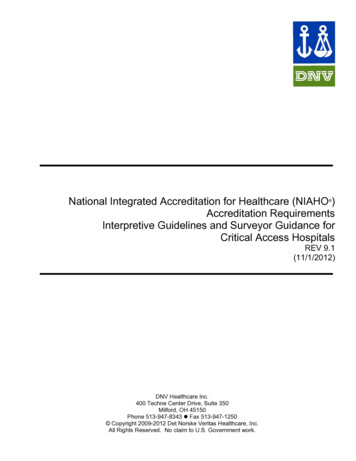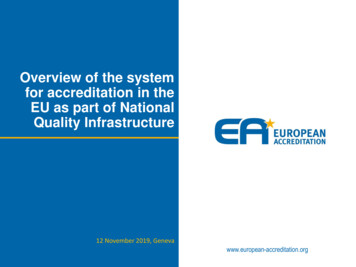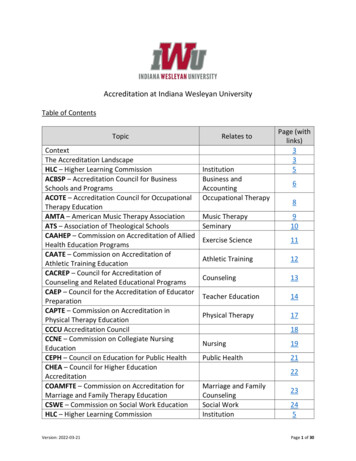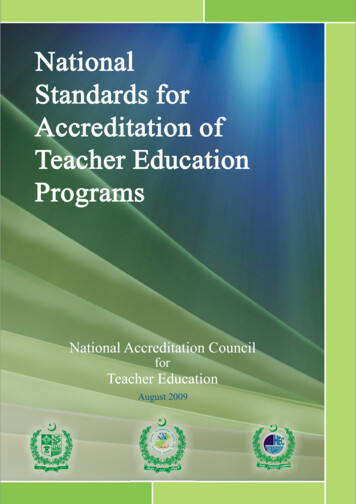
Transcription
NationalStandards forAccreditation ofTeacher EducationProgramsNational Accreditation CouncilforTeacher EducationAugust 2009HIGHEREDUCATIONCOMMISSION
NationalNational Accreditation CouncilforTeacher EducationAugust 2009HIGHEREDUCATIONCOMMISSION
Contents
PrefaceTeacher education in Pakistan is witnessing a visible change and concern for qualityassurance and enhancement. Standards based education, in general and teachereducation in particular, is part of global movement of quality assurance.Pakistan aspires to develop a world class education system which is not possible withoutcompetent and quality teachers dedicated to their profession. To prepare such teachersand empower them to educate the future generations, the fundamental requirements arevery much available in the professional literature which include standards of what aTeacher Education Program should be and be able to produce.To ensure and enhance the quality of teacher education, the HEC has constituted theNational Accreditation Council for Teacher Education (NACTE) as an autonomousbody to accredit all teacher education programs offered in the public and private sectorinstitutions in the country. For this purpose, NACTE has developed National Standardsfor Accreditation of Teacher Education Programs. These standards define therequirements for specific and essential components of a teacher education program.They guide towards the detailed documentation of program and processes foraccreditation.These standards are meant to support teacher education programs, in particular andinstitutions in general, as they spiral through the development stages. An importantfunction of standards is to inculcate professionalism among teacher educators andprospective teachers. The policy makers at the national and provincial levels in thepublic and private organizations interested to improve and support any teacher educationprogram may use these standards as guidelines. These standards can help to link theschool system with teacher education programs. These can also provide a framework forconducting and evaluating research related to teacher education.The standards embody a set of concepts or theoretical ideas about accreditation. Theseconcepts have been translated into standards as statements of principles. Each standardconsists of several elements representing the policies, practices and the consequencesassociated with it. Each element further comprises certain indicators meant tooperationalize it to provide guidelines for measurement and assessment.The accreditation standards development process was an extensive exercise. It startedwith the review of the relevant literature. The existing practices of quality assurance andenhancement of teacher education at national and international levels were studied.Current developments in accreditation and program approval policies and practices indeveloped and developing countries like USA, UK, Australia, Canada, India, HongKong and Philippine were reviewed in specific.
These standards were developed in line with an agreed framework and were discussedand reviewed at provincial and national levels by the professionals and policy makersand at international level by the experts on accreditation of teacher education programs.The consultation process was in the form of meetings, and workshops. Consensus wasdeveloped among all the stakeholders on the standards at provincial and nationalworkshops in June, 2009. The standards were then approved by the NACTE in July2009.We are deeply indebted to UNESCO and USAID for supporting the lengthy process ofstandards’ development. Thanks are due to the participants of provincial and nationalworkshops/consultations for their valuable comments and suggestions. We alsoacknowledge the contribution made by the international consultants. Lastly, the hardwork of the staff at the NACTE secretariat, from drafting to the finalization of standards,is acknowledged with appreciation.Dr. Munawar S. MirzaChairpersonNational Accreditation Council forTeacher Education (NACTE)iv
Standards for Accreditation ofTeacher Education ProgramsConceptualFrameworkStandard 1: Curriculum and InstructionStandard 2: Assessment and Evaluation SystemStandard 3: Physical Infrastructure, Academic Facilitiesand Learning ResourcesStandard 4: Human ResourcesStandard 5: Finance and ManagementStandard 6: Research and ScholarshipStandard 7: Community Links and Outreach1
1Conceptual FrameworkProgram EthosThe program has developed a knowledge-based shared vision to prepare committedand competent teachers and educationists.A. Mission StatementThe program has stated its vision, mission, goals and objectives.A.1 The vision and mission of the institution are in accordance with its legal and educational mandate.A.2 Goals and objectives are aligned to each other and to the vision and mission statements.A.3 The curriculum and instructional strategies relate to the goals and objectives.A.4 The document presenting the mission statement contains a brief description of the assessment andevaluation system of the program.B. CoherenceThe components of the program are coherent and cohesive.B.1 There is evidence of inter and intra coherence and integration among all components of the programi.e., the courses, teaching strategies, performance standards of prospective teachers, methods ofassessment and evaluation, adequateness of infrastructure and efficiency of the program.B.2 The plan of the program is aligned with its mission, goals and objectives.1 Thissection establishes the conceptual framework of the program and is a pre-requisite ofaccreditation.2
Standard 1: Curriculum and InstructionCurriculum is properly designed to attain the National Professional Standards for Teachers,is approved by the competent authority and disseminated to all concerned.*1.1 Curriculum Development ProcessThe curriculum is developed based on national policies, consulting all stakeholdersand assuring regular and recurrent revisions.1.1.1 The curriculum is designed in line with the provisions of the national education policies andprofessional standards for teachers.1.1.2 The curriculum development process involves key stakeholders.1.1.3 The curriculum is approved by the competent authority.1.1.4 There is provision for periodic and research-based revision of the curriculum to achieve statedobjectives effectively.1.1.5 The revisions/ updating of the curriculum is disseminated and shared with the concerned TeacherEducation Institutions.*1.2 Curriculum Content and Description of the ProgramThe curriculum presents a detailed description of the program that is flexible,updated and appropriate for diverse spheres of the professional, personal, presentand future development of prospective teachers.1.2.1 The curriculum content is inclusive enough to effectively reflect and include the concerns andexpectations of a teacher.1.2.2 The curriculum content is appropriate and relevant to develop knowledge, skills and dispositionsexpected of a teacher.1.2.3 The curriculum content includes both theoretical and practical inputs.1.2.4 The curriculum content provides a variety of learning experiences in the institution and practicingschool.3
Standard 1: Curriculum and Instruction1.2.5 The curriculum content is compatible with the changing and emerging needs of the society.1.2.6 The curriculum document includes duration of the program (number of years, semesters andcredit hours) and course outlines.1.2.7 The course credit hours and duration of the program meet the minimum requirements of theHigher Education Commission.1.2.8 The course credit hours and duration of concurrent degree program is equal to relevant andequivalent degrees.1.2.9 The curriculum content and duration of program /courses are compatible to each other.1.2.10 The program includes a mandatory course on application of Information and CommunicationTechnology.1.2.11 Information and Communication Technology is integrated into the curriculum.1.2.12 The curriculum or its course outlines provide lists of web sites and recommended books ofrecent editions for each course.1.34Course Transaction and Classroom ManagementCourse activities are designed and conducted to facilitate the learning and teachingexperience in a conducive and interactive classroom environment.
Standard 1: Curriculum and Instruction1.4Teaching Learning Procedures and MethodsTeacher educators deliver course content using appropriate, varied and innovativemethodologies.1.5Teaching Practice and InternshipThere is a mechanism for prospective teachers to undergo teaching practice andinternship to enrich their learning experience and provide them with adequate feedback.5
Standard 2: Assessment and Evaluation SystemThe institution has a fair and transparent assessment and monitoring system thatfollows-up on various traits of prospective teachers from entry to exit of theprogram, monitors the performance of the teacher educators and evaluatesinstitutional functioning for individual and institutional consumption and programimprovement.2.1Assessment and Evaluation System of the ProgramThere is evidence that the program plans and provides activities that will fostereducational quality based on feedback from valid assessment.2.1.1 The assessment system is based on the objectives of the program.2.1.2 There is evidence that the teacher educators and stakeholders monitor and provide constantfeedback for regular review and revision of the assessment system.2.1.3 The system collects data from multiple assessments at various transition points.2.1.4 The assessment system has procedures to ensure fairness, accuracy, consistency and transparencyof its procedures and operations.2.1.5 The results from the assessments are disseminated to all stakeholders.2.1.6 There is a feedback mechanism that is used by teacher educators, prospective teachers and otherstakeholders.2.1.7 Complete record of the stakeholders’ written complaints, with their follow-up and resolutions, ismaintained.2.1.8 Quality improvement plans are developed, implemented and monitored based on the assessmentresults, feedback and complaints of the stakeholders.2.1.9 There is evidence that actions have been taken according to the mechanism that links theassessment system with the quality of the program.2.1.10 There is a system for seeking regular and periodic feedback about the program from alumni andtheir employers.6
Standard 2: Assessment and Evaluation System2.2Maintenance of an Assessment SystemThere is evidence that an assessment system is put in place, adequately andtransparently managed to produce useful information, following ethical guidelinesand the individuals' right to privacy.2.2.1 The assessment system is documented and disseminated.2.2.2 The system has a mechanism to provide timely feedback to those who are assessed.2.2.3 There is adequate evidence that the procedures and tools used for assessment of the system aresystematic, valid and reliable.2.2.4 A record of all assessments conducted during the program is maintained.2.2.5 The assessment system is maintained, using appropriate information technologies.2.2.6 The assessment system adheres to the established/standard implementation procedures.2.2.7 The assessment calendars and notified transition periods for evolution of teacher educators andprospective teachers are followed.2.2.8 There is evidence that the date collected have been analyzed using appropriate procedures todetermine the quality of learning.2.2.9 There is evidence that an appropriate procedure to protect the individual’s right to privacy whenaccess is provided to the assessment data.2.3Assessment and Monitoring of Prospective TeachersSystematic, valid and reliable procedures and tools are used to assess prospectiveteachers with the intention of using the date to improve educations quality.2.3.1 There are mechanisms and procedures to monitor prospective teachers' performance throughoutthe program.2.3.2 The system provides for the assessment of prospective teachers’ knowledge, skills anddispositions as laid down in the National Professional Standards for Teachers in Pakistan.2.3.3 There is evidence that the procedures and tools used for assessment of prospective teachers aresystematic, valid and reliable.2.3.4 There is evidence that assessment data of prospective teachers is used systematically andregularly to improve their performance, program effectiveness and institutional development.7
Standard 2: Assessment and Evaluation System2.4Assessment and Monitoring of Teacher EducatorsSystematic, valid and reliable procedures and tools are used to assess TeacherEducators with the objective of using the data to improve quality of teaching and learning.2.4.1 The system describes mechanisms and procedures to monitor the performance of the teachereducators.2.4.2 The system provides mechanisms for the assessment of teacher educators’ knowledge, skills anddispositions.2.4.3 There is evidence that the procedures and tools used for assessment of teacher educators aresystematic, valid and reliable.2.4.4 The system provides for the assessment of the teacher educators’ practice of teaching, research,publications and scholarly work.2.4.5 There is evidence that assessment data of teacher educators is used systematically and regularlyfor the improvement of teacher educators, program and institution.2.4.6 There is a mechanism available for the regular assessment of all the teacher educators by the headof the program, peers and prospective teachers.8
Standard 3: Physical Infrastructure, AcademicFacilities and Learning ResourcesThe program is provided with adequate and necessary facilities, infrastructure andlearning resources to prepare teachers following the prescribed curriculum andproviding opportunities for supervised teaching practice and internship throughlinkages with the school system.3.1FacilitiesThe institution offering the program has facilities that ensure a safe, healthy andacademic environment.3.1.1 The institution is located in an independent building or buildings.3.1.2 The institution is located in a hazard free environment.3.1.3 The building/buildings where the program is offered is/are well designed, well constructed, andsafe.3.1.4 The building caters for the need of special people.3.1.5 There is an adequate number of classrooms, lecture theaters and laboratories to accommodate thenumber of courses offered.3.1.6 Classrooms, lecture theaters and laboratories are of adequate size to accommodated the expectednumber of prospective teachers.3.1.7 Classrooms and laboratories are equipped with the facilities and equipment requited for thecourses hosted there.3.1.8 Enough space is allocated in the institution for leisure, artistic and physical activities.3.2LibraryThe institution that hosts the program has an accessible and well-equipped library.3.2.1 The library is strategically located to be accessible to all teacher educators and prospectiveteachers.9
Standard 3: Physical Infrastructure, Academic Facilities and Learning Resources3.2.2 The library is functionally designed.3.2.3 The library is managed by an adequate number of qualified, trained and professional staff.3.2.4 The library is furnished with well designed furniture, proper storage, shelving and electronicequipment.3.2.5 The library comprises of various types of information sources (i.e. print, non-print, electronic anddigital materials).3.2.6 The national documents on teacher education are available in the library (e.g., programcurriculum, National Professional Standards for Teachers in Pakistan).3.2.7 There is evidence that the library is regularly upgraded.3.2.8 The library collection includes all the recommended books mentioned in the syllabus / curriculumdocument of the program.3.3Orientation and SupportThe program provides prospective teachers with the necessary opportunities tolearn from the teacher educators, and cooperative teachers as they put into actiontheir newly acquired competencies.3.3.1 The program is associated with the number of schools necessary for all prospective teachers topractice / do internship.3.3.2 A follow-up file is kept of all prospective teachers in internship / teaching practice.3.3.3 There is a program follow-up team to monitor all program activities concerning the prospectiveteachers.10
Standard 4: Human ResourcesThe institution maintains, develops and supports experienced leadership, qualifiedteacher educators and competent support staff to conduct the program through aninbuilt staff-development mechanism.*4.1 RecruitmentThe program recruits the necessary personnel through transparent procedures andcriteria.4.1.1 There is a formal appointment/placement policy for teacher educators.4.1.2 The institution recommends the required number of positions.4.1.3 There is evidence for recruitment of the necessary number of specialized and professionalteacher educators.4.1.4 The profile of recruited teacher educators available fits with the courses offered by the program.4.1.5 The necessary number of support staff is recruited.4.1.6 There is evidence that recruitment procedures were conducted in a transparent manner followingnotified criteria.4.1.7 There is evidence that the selection and posting of the head of the program/ institution hosting theprogram followed procedures that were conducted in a transparent manner following notifiedcriteria.4.2Professional ConductThe teacher educators and support-staff follow professional ethics in their behavior.4.2.1 A written professional code of ethics is available.4.2.2 There is evidence that there is follow-up to the teacher educator and support staff’s observanceof the professional code of conduct and ethics.11
Standard 4: Human Resources4.3Professional DevelopmentThe teacher educators and support-staff take advantage of the opportunitiesprovided by the program of institution for professional development.4.3.1 The program has a documented teacher educators’ professional development process based onjustified priorities.4.3.2 The support staff demonstrates knowledge and skills of recent trends and allied resources in theirfield.4.3.3 The teacher educators demonstrate competence and knowledge of recent educational trends, andresources in teaching.4.3.4 Teacher educators participate in the professional development programs.4.4Workload of Teacher Educators’ and Support StaffTeacher educators and support staff follow a clear policy for the distribution ofworkload.4.4.1 The program implements a policy for the distribution of workload for different ranks (includingteaching, supervision of practice teaching and research) that has been notified and madeavailable by the competent authority.4.4.2 Workload of teacher educators allocates time for planning of instruction, supervision, practiceteaching, research and participation in community outreach.4.4.3 A prescribed prospective teacher-teacher educator ratio is consistently followed for all programrelated activities.4.5Incentives for RetentionA clear incentive system is devised and executed to enhance retention of teachereducators and support staff.4.5.1 The program has developed and documented its performance-based merit system and career path.4.5.2 The program implements an incentive-based strategy to foster retention of qualified teachereducators.4.5.3 There is an accurate registry of teacher educators and staff awarded and rewarded with incentivesand professional development opportunities.4.5.4 There is evidence that incentives are provided to support staff involved in additional work.12
Standard 5: Finance and ManagementThere is transparent, competent and strategic management of administrative andfinancial matters of the program and its host institution.5.1Budget of the ProgramThe Program manages its budget transparently and accrues independent funds whenpossible.5.1.1 There is evidence of accurate and timely dissemination of information regarding fundingopportunities for different types of the programs (e.g. research, maintenance, staffdevelopment)5.1.2 The program maintains its budget transparently abiding by the financial rules and followingstandard procedures.5.1.3 There is evidence that efforts have been made to accrue funds for the development of teachereducators and support staff.5.1.4 There is evidence that efforts have been made to accrue funds to conduct and disseminate research.5.1.5 There is evidence that efforts have been made to accrue funds for outreach programs.*5.1.6 A separate and regular budget is allocated for the updating and maintenance of library,laboratory and other resources.5.2ManagementThe program is effectively and efficiently managed.5.2.1 The program maintains written policies and procedures for its internal management andoperational activities.5.2.2 The program has a set of rules and regulation regarding all academics and administrative mattersunder its jurisdiction5.2.3 All academic and administrative matters of the program are managed through notified boards orcommittees.5.2.4 The program monitors the adherence of its members to the policies, procedures, rules andregulations.13
Standard 5: Finance and Management5.2.5 The program has a document that clearly defines the roles and functions of staff and teachereducators.5.2.6 Stakeholders are aware of the roles and functions of staff and teachers educators.5.2.7 There is an annual calendar that has been produced with participation of teacher educator andstaff.5.2.8 The annual calendar of the program is disseminated and available to all the stakeholders.*5.2.9 The program follows an admission policy and clear pre-requisites.5.2.10 There is evidence that orientation about the program and institution is provided to the enteringprospective teachers.5.2.11 The class size and prospective teachers grouping for all academic activities (e.g. classes,research, practice teaching) are well defined.*5.2.12 The graduation and certification requirements of the program are well-defined, clearly statedand documented.5.2.13 The institution has procedures to verify that the graduating teachers have met the requirementsfor certification.5.3Retention of Prospective TeachersThe program provides an environment and instruction that retains competentprospective teachers.5.3.1 The program keeps records of enrolment, promotion and retention.5.3.2 The program keeps records of drop-out rates and reasons for drop-out.5.3.3 The program develop yearly plan to minimize drop-out rate.5.3.4 There is evidence of the implementation of incentives.5.3.5 The institution plans and implements an effective program of prospective teachers' supportservice, including co-curricular activities.5.3.6 The institution supports prospective teachers to avail facilities of support services.5.3.7 All the support services for prospective teachers are managed by professional and qualified staffwith provision of adequate physical and financial resources.5.3.8 The program provides merit and need based scholarship to prospective teachers.5.3.9 The program provides remedial and counseling service to perspective teachers.14
Standard 6: Research and ScholarshipThe program facilities its educators and prospective teachers to undertakeresearch, at the individual and institutional level, to promote the educationalprocess.6.1Program's Research and Knowledge Generation PlanThe program has a knowledge generation / research plan that covers a wide rangeof relevant local, national and international issues.6.1.1 There is evidence that the program develops and executes a research plan.6.1.2 The planning and conduct of research is in consonance with local and national priorities.6.1.3 Research addresses the issues related to teacher education programs and institutions to ensure andimprove the quality of education.6.1.4 Incentives are provided to the teacher educators and prospective teachers engaged in conductingresearch.6.2Dissemination and Use of Research OutputsThe research outputs are disseminated to the concerned stakeholders and are usedfor the improvement of the program and institution.6.2.1 There is evidence that measures are undertaken to encourage publication and dissemination ofongoing or completed research.6.2.2 There are documented mechanisms to improve the teaching and learning processed based on theresearch finding and results.6.2.3 There is evidence that efforts are made to use research findings and results to improve teachingand learning.6.2.4 The program follows a consistent policy of knowledge generation by developing academicactivities and instructional materials.6.2.5 The program shares experiences and services with concerned institutions.15
Standard 7: Community Links and OutreachThe institution has link and interacts with its community to mutually support eachother to develop and strengthen an equitable society.7.1Linkage with the CommunityThe program sustains a constant dialogue with the community for mutual benefitand support.7.1.1 The institution has developed a well thought out plan of extension projects based on socialneeds and educational issues of the community.7.1.2 There are activates in the program where community members participate in the planning andimplementation of projects (e.g. school community development plans, capacity building ofteachers)7.1.3 Members of the staff, teacher educators and prospective teachers have active roles in thecommunity development and outreach projects.7.1.4 There is evidence that services of different professionals in the community are used to supportand improve the programs.7.2Supporting an Equitable and Fair CommunityThe program takes measures to assure that its treatment is fair, equitable andsupportive to members of society.7.2.1 The institution follows clearly defined policies and procedures regarding gender issues for theselection, promotion, retention and other matters that affect teacher educators, staff andprospective teachers.7.2.2 The program is conducted in a conducive, open, and harmonious environment, free ofdiscrimination.16
* This element / indicator will not be evaluated for the institution that does not;develop its own curriculumdevelop official admission and graduation policyhave control over recruitment proceduresreceive a regular allocation of funds for the libraryIn such cases, when the accreditation procedures are applied, an adaptation ofthe scoring procedure will be used for fair assessment.17
Participants of Provincial and National ConsultationMeetings on Standards for Accreditation of TeacherEducation ProgramsFour consultative meetings were held from 15 June to 30 June of 2009 to review and finalize the standardsfor accreditation of teacher education programs. These meetings were held in Islamabad, Lahore andKarachi,bringing together representative from every province and area in the country.Provincial / Area / National consultations have been conducted in the following dates:15 June 2009 - NWFP, Balochistan, FATA, FANA, AJK18 June 2009 - Punjab23 June 2009 - Sindh30 June 2009 - National Consultation in IslamabadFederal Ministry of Education1. Mr. Pervez Iqbal, Joint Educational Advisor, Policy and Planning Wing, Ministry of EducationIslamabad2. Mr. T. M. Qureshi, Deputy Educational Advisor and Focal Officer STEP UNESCO, Ministry ofEducation, Policy and Planning Wing, IslamabadHigher Education Commission (HEC)3. Dr. S. Sohail H. Naqvi, Executive Director, Higher Education Commission (HEC), Islamabad4. Dr. Azam Ali Khwaja, Managing Director, Quality Assurance, HEC, Islamabad5. Dr. Noor Amna Malik, Director General, Learning Innovation Division, HEC IslamabadAcademicians and Representatives of Provincial Government6. Dr. Munawar S. Mirza, Chairperson NACTE, Vice Chancellor, University of Education, Lahore7. Dr. Mahmood ul Hassan Butt Vice Chairman, NACTE & Vice Chancellor, Allama Iqbal OpenUniversity, Islamabad8. Dr. Rehana Masroor, Dean Faculty of Education, Allama Iqbal Open University, Islamabad9. Dr. Muzaffar Abbas, Director Division of Arts Social Sciences, University of Education, Lahore18
Participants of Provincial and National Consultation Meetings10.Dr. Hafiz Muhammad Iqbal, Dean Faculty of Education, University of the Punjab,Lahore.11.Dr. Parveen Munshi, Dean Faculty of Education University of Sindh, Hyderabad12.Dr James Shafi, Dean of Education, Forman Christian College, Lahore13.Dr. Muhammad Memon, Director for Educational Development, Agha Khan University,Karachi14.Mr. Talat Khursheed, Director, Federal College Education, H-9, Islamabad15.Dr. Ijaz Ahmad, Associate Professor/Chairman of Education, University of Balochistan, Quetta16.Mr. Javed Iqbal Nasir, Director, Bureau of Curriculum and Extension Centre Quetta17.Mr. Nazar Mohammad Kakar, Assistant Professor , Government College of Education, Quetta18.Ms. Simab Rafique, Senior Research Officer, Bureau of Curriculum and Extension Center, Quetta19.Ms. Shahnaz Akhter, Assistant Professor, Department of Education, University of Balochistan,Quetta20.Mr. Mohammad Aamir Khan, Information Officer, Society for Community Education (SCSPEB),Qutta21.Ms. Misbah Khurshid, Principal, Government College of Elementary Teachers, Talagang,Chakwal22.Dr. Riffat Un Nisa Awan, Assistant Professor, University of Sargodha23.Mr. Charagh Din Arif, Director, Curriculum Wing, Punjab Text Book Board, Lahore24.Mr. Nasrullah Virk, Additional Director, Directorate of Staff Development, Lahore25.Dr. Muhammad Saeed, Director, Provincial Institute of Teachers Education (PITE) Lahore26.Dr. Khalid Rasheed, Additional Director, Admin, University of Education, Lahore27.Ms. Shahida Jabeen, Director Admin, Directorate of Public Instructions, Lahore28.Mr. Muzahir Hussain, Principal, Government College for Elementary Teachers (GCET), Lahore29.Syed Tassaduq Hussain Bokhari, Senior Subject Specialist, GCET, Lahore30.Dr. Humala S. Khalid, Dean of Social Sciences, Lahore College for Women University, Lahore31.Ms. Yasira Waqar, Assist
Teacher Education Program should be and be able to produce. To ensure and enhance the quality of teacher education, the HEC has constituted the National Accreditation Council for Teacher Education (NACTE) as an autonomous body to accredit all teacher education programs offered in the public and private sector institutions in the country.







